
The Wigwam Motels, also known as the "Wigwam Villages," is a motel chain in the United States built during the 1930s and 1940s. The rooms are built in the form of tipis, mistakenly referred to as wigwams. It originally had seven different locations: two locations in Kentucky and one each in Alabama, Florida, Arizona, Louisiana, and California.

The Aztec Motel, also known as the Aztec Auto Court or Aztec Lodge, was a historic motel located on former U.S. Route 66 in the Upper Nob Hill neighborhood of Albuquerque, New Mexico, United States. Until its demolition in 2011 it was the oldest continuously-operating Route 66 motel in New Mexico and "one of the five most important motels left" in Albuquerque.
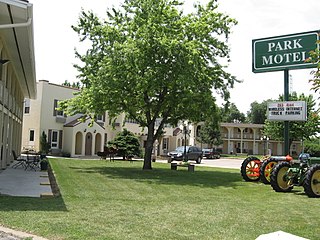
The Park Motel is a historic building located in Denison, Iowa, United States. It is an example of a well-preserved highway motel during the early age of motoring. It appears this is also an early example of a "motel" in Iowa and may be one of the earliest in the Midwest.

The Wildwoods Shore Resort Historic District, or Doo Wop Motel District, is an area in The Wildwoods, New Jersey, that was home to over 300 motels built during the Doo-Wop era of the 1950s and 1960s. Officially recognized as a historic district by the State of New Jersey, it lies primarily in the municipality of Wildwood Crest, along a two-mile stretch between Atlantic and Ocean avenues, and includes areas in Wildwood and North Wildwood. The term doo-wop was coined by Cape May's Mid-Atlantic Center for the Arts in the early 1990s to describe the unique, space-age architectural style, which is also referred to as the Googie or populuxe style.

Ronald and Penelope Bucsek were the first motel owners to introduce the plastic palm trees to Wildwood, NJ at the Starfire Motel. The Caribbean Motel, as well as many other other motels in Wildwood, quickly Incorporated this retro look into their designs.

Chateau Bleu Motel is located in North Wildwood, Cape May County, New Jersey, United States, in an area now known as the Wildwoods Shore Resort Historic District. The building was built in 1962 in the distinctive "Googie" or "Doo Wop" architectural style. Googie details include the heart shaped swimming pool and the spikes at the entrance. The motel was added to the National Register of Historic Places on March 25, 2004.
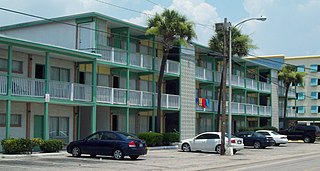
Rainbow Court was a historic hotel complex located at Myrtle Beach in Horry County, South Carolina. The complex of buildings ranged in dates of construction from 1935 to 1959. The complex included: two motel-type buildings, five beach cottages/boarding houses, and a small house. The buildings are situated around an open court with a swimming pool. There were six contributing buildings. It was one of the few remaining examples of the small-scale, low-rise motels that pre-dated Hurricane Hazel (1954).
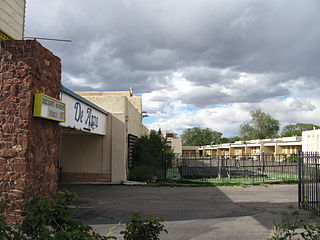
The De Anza Motor Lodge was a historic motel located on former U.S. Route 66 in the Upper Nob Hill neighborhood of Albuquerque, New Mexico. It was built in 1939 by Charles G. Wallace, a local trader of Zuni art and pottery, who remained the owner until 1983. Wallace decorated the motel with a variety of Native American art, including a series of murals by Zuni artist Tony Edaakie in a basement room.

The Wagon Wheel Motel, Café and Station in Cuba, Missouri, is a 19-room independently owned historic U.S. Route 66 restored motel which has been serving travelers since 1938. The site opened as a café in 1936; the motel has remained in continuous operation since 1938. The motel rooms were fully restored in 2010, adding modern amenities such as HDTV and wireless Internet.

The Coral Court Motel was a 1941 U.S. Route 66 motel constructed in Marlborough, Missouri and designated on the National Register of Historic Places in St. Louis County in 1989 as a valuable example of the art deco and streamline moderne architectural styles. It expanded to 77 rooms in the heyday of automobile tourism on US 66, only to decline after the highway was bypassed by Interstate 44 in the 1970s and close its doors forever in 1993. Despite strong local efforts advocating historic preservation, it was demolished in 1995 for a suburban housing development.

The Munger Moss Motel is a motel in Lebanon, Missouri. It was built in 1946 as an addition to a roadside restaurant and filling station, both of which are now gone. The site's Munger-Moss Sandwich Shop served travellers on U.S. Route 66 in Missouri, circa 1936. Located on the Big Piney River at Devil's Elbow, Missouri until 1945, it relocated to Lebanon, Missouri after World War II when construction of a four-lane bypass of U.S. Route 66 in Missouri to Fort Leonard Wood drew traffic away from the original Munger Moss BBQ site.

The Cactus Motor Lodge, now known as the Cactus RV Park, is a motel located along historic U.S. Route 66 in Tucumcari, New Mexico. I.E. and Edna Perry built the lodge in 1941. The motel included three wings of units forming a "U" shape and an office, the latter of which was a dance hall when the motel opened. In 1952, Norm Wegner purchased the motel; Wegner added an artificial stone exterior to the buildings and converted the dance hall to an office. After Route 66 was decommissioned, the motel lost much of its business, and by the 1990s it became an RV park; the motel units are currently unused. The motel's neon sign was restored in 2008. In October 2018, the sign was sold and removed to be relocated to an Albuquerque neon-sign park. Many other items have been sold off as the current owners negotiate to sell the property itself to O'Reilly Auto Parts.

The West Winds Motel is a historic motel located on old U.S. Route 66 in Erick, Oklahoma. The motel opened in the mid-1940s to serve travelers on Route 66; at the time, tourism drove Erick's economy, and the motel was one of several in the city. The motel had a typical motor court layout with two lodging buildings and an office forming a "U" shape around a central courtyard. The lodging buildings have a Mission Revival design with stucco walls and red metal roofs designed to resemble tile. The motel units have individual garage spaces in front of their entrances, a style which was common in the 1930s and 1940s but fell out of favor in later years.

Sea Foam Motel is a historic motel located at Nags Head, Dare County, North Carolina. It was built in 1948 with additions made through 1964, and is a one- to two-story, Modern style brick building. It consists of three major sections that form a "U"-shape enclosing a large parking area on three sides. Also on the property are the contributing swimming pool (1948), playground, and shuffle board court.

Harrisonville Courthouse Square Historic District is a national historic district located at Harrisonville, Cass County, Missouri. The district includes 34 contributing buildings, 1 contributing structure, and 1 contributing object in the central business district of Harrisonville. It developed between about 1880 and 1943, and includes representative examples of Italianate, Queen Anne, Colonial Revival, Tudor Revival, and Renaissance Revival style architecture. Notable buildings include the Cass County Courthouse (1897), New Method Laundry (1929), Cass County Democrat, Wooldridge Building, Bank of Harrisonville (1900-1901), Wirt's Opera House Building, Post Office Building (1925), Emmons Building/Bowman Building (1887), Evans Building (1890), White Motor Company, Stephen Stuart "Racket" Store, First National Bank of Harrisonville, and Deacon Building (1892).
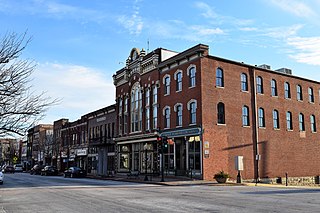
Missouri State Capitol Historic District is a national historic district located at Jefferson City, Cole County, Missouri. It encompasses 122 contributing buildings in the central business district of Jefferson City. The district developed between about 1850 and 1950, and includes representative examples of Classical Revival, Late Victorian, Queen Anne, Mission Revival, and Modern Movement style architecture. Located in the district are the separately listed Missouri State Capitol, Lohman's Landing Building, Cole County Historical Society Building, Cole County Courthouse and Jail-Sheriff's House, Missouri Governor's Mansion, and Tergin Apartment Building. Other notable buildings include the St. Peter's Roman Catholic Church complex (1881-1883), Margaret Upshulte House, Broadway State Office Building (1938), Supreme Court of Missouri (1905-1906), U.S. Post Office and Courthouse (1932-1934), Lohman's Opera House, Missouri State Optical, First United Methodist Church (1900), Carnegie Public Library (1901), Temple Beth El (1883), and Joseph and Susie Kolkmeyer House.
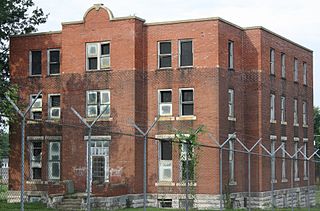
Chillicothe Industrial Home for Girls, also known as Chillicothe Correctional Center, is a national historic district located at Chillicothe, Livingston County, Missouri. The district encompasses 10 contributing buildings, 1 contributing site, and 7 contributing structures, at a former industrial home. It developed between about 1889 and 1970, and includes representative examples of Colonial Revival and Streamline Moderne style architecture. Notable buildings include the McReynolds Cottage (188-1889) by Morris Frederick Bell, who also designed the original campus; Blair Cottage (1957-1958); Hearnes Office Building and Clinic (1967-1968); Donnelly Cottage (1957-1958); Stark Cottage (1937-1938); Hyde School (1922); Park Cottage (1937-1938); Food Service Building (1957-1958); Laundry ; Power House. The home officially closed as a juvenile facility in 1980 and re-opened as an adult correctional center in 1981. The new Chillicothe Correctional Center opened in 2008, and the former Industrial Home site was declared surplus.
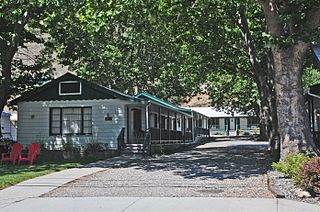
The Riggins Motel, at 615 S. State Highway 95 in Riggins in Idaho County, Idaho, was listed on the National Register of Historic Places in 2001. It has also been known as Rowe Motel. The listing included five contributing buildings and a contributing object.

























